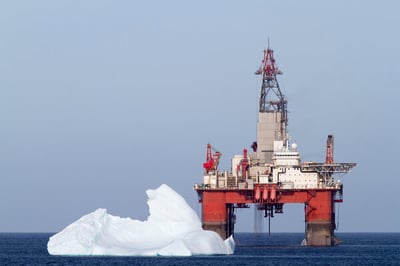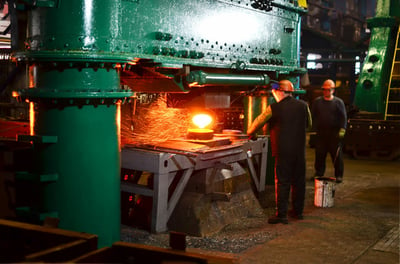Hydraulic systems are vital to the operation of industrial equipment and heavy machinery. They are integral from the manufacturing of parts to systems that power agricultural combines. In any application, hydraulic hoses can fail due to selection of the wrong hose over pressurizing, improper installation of fittings and more. Yet a commonly overlooked potential hazard is extreme temperatures. Both high and low temperatures can a have significant effect on the efficiency, performance, and safety of a hydraulic system.
Operating Hydraulic Systems at Low Temperatures
Cold temperatures can have a highly destructive effect on hydraulic systems. Consider the extremely cold conditions of Norway’s oil platforms in the Barents Sea where ambient temperatures can get down to -22°F (-30°C). Even operating heavy equipment like backhoes in extreme winter conditions can have adverse effects on hydraulic hose. Operating hydraulic systems at high-altitudes and low-atmospheric conditions can result in a similar outcome.
Norway’s oil platforms in the Barents Sea where ambient temperatures can get down to -22°F (-30°C). Even operating heavy equipment like backhoes in extreme winter conditions can have adverse effects on hydraulic hose. Operating hydraulic systems at high-altitudes and low-atmospheric conditions can result in a similar outcome.
Not only can exposure to extreme cold can permanently change the flexibility of hydraulic hose, fluctuations of temperature while warming back up during operation can cause the hose to become stiff and subject to cracking, too.
The elastomeric materials, such as rubber, that make up the outer shell and inner core of hydraulic hoses can become brittle when temperatures drop. In addition, other rubber components such as O-ring seals, clamps and mounts made of polypropylene can be seriously damaged in extreme cold, resulting in cracks or tears in the material.
Cold temperatures will also increase the viscosity of hydraulic fluid and oil, causing it to become thicker. Higher viscosity reduces the fluid’s ability to evenly lubricate around critical parts. It can even congeal, which will stop the flow and ultimately cause damage to working components. This will cause pumps to be starved of lubrication, producing cavitation which occurs when the liquid in the pump turns to a vapor. This lack of lubrication will lead to expensive damage to equipment and costly downtime.
Operating Hydraulic Systems at High Temperatures
Hydraulic hoses can be subject to high temperatures from the heat carried by the hydraulic fluid inside the tube. They can also be exposed to heat from the exterior environment: if hoses are near heavy machinery, they can easily absorb their heat.
All hydraulic hoses have specific temperature ratings designating their maximum allowable working temperature. Overheating can cause the plasticizers in the hose walls to lose flexibility, resulting in hardening and brittleness which can lead to cracks and leakage.
Internal heat resulting from high fluid temperature, or an increased heat load can cause the system’s inability to dissipate heat. These conditions can be triggered by excessive high-duty cycling, extreme workloads, or damaged components causing internal leakage.
Hydraulic fluids and lubricants will begin to experience permanent deterioration and a severe reduction in viscosity when subjected to high temperatures for an extended period. The reduction in viscosity due to heat causes the fluid to be thinner and less viscus, like adding thinner to paint. Hydraulic fluid that loses viscosity leads to oxidation which will turn it into sludge, resulting in chemical reactions that degrade additives, seriously compromising the performance of the fluid. The result in over heating causes hydraulic oils and lubricants to become useless, allowing friction to significantly increase and accelerate wear on system parts and/or total catastrophic failure. The use of certain additives can help reduce viscosity loss, yet extended heat exposure can cause most additives to break down too.
Conclusion
Most hydraulic hoses are rated for -40°F (-40°C) to +212°F (+100°C). Some specialty hydraulic hoses can withstand -55°F (-48°C) to +300°F (+149°C) depending on the number of spiral or braided wires, and type of elastomeric material.
Unless the hydraulic system is properly protected, extreme or drastic swings in temperature will adversely affect the performance likely causing extensive damage, costly downtime, and even serious injury. From hydraulic forging presses operating at extremely high temperatures in a plant, to pumps on oil platforms in the arctic, hydraulic hoses must be able to withstand extremes in temperature. Protecting against these environments comes down to proper hose selection, using the right hydraulic fluid and additives, sometimes using a protective wrap or sleeve, and frequent monitoring of the hose and fluids. The biggest impact of temperature on hydraulic systems involves the viscosity of fluids. Very high temperatures will diminish the viscosity of the fluid making it thinner, whereas very cold temperatures will increase viscosity, making it thicker. These changes in the viscosity of hydraulic fluid can be a primary cause of permanent damage to the system and its components, making it extremely important to frequently monitor fluid, and the temperature environment.
Learn more about hydraulic safety in our whitepaper titled, "Hydraulic Safety Begins With the Design."
Sources Include:

